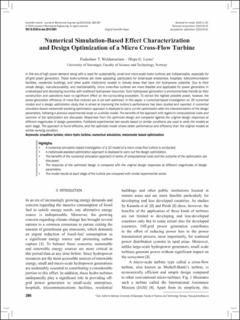| dc.contributor.author | Woldemariam, Endashaw Tesfaye | |
| dc.contributor.author | Lemu, Hirpa G. | |
| dc.date.accessioned | 2023-01-25T14:56:19Z | |
| dc.date.available | 2023-01-25T14:56:19Z | |
| dc.date.created | 2019-08-06T14:26:36Z | |
| dc.date.issued | 2019 | |
| dc.identifier.citation | Woldemariam, E. T., & Lemu, H. G. (2019). Numerical Simulation-Based Effect Characterization and Design Optimization of a Micro Cross-Flow Turbine. Strojniski Vestnik/Journal of Mechanical Engineering, 65(6), 386-397. | en_US |
| dc.identifier.issn | 0039-2480 | |
| dc.identifier.uri | https://hdl.handle.net/11250/3046397 | |
| dc.description.abstract | In this era of high power demand along with a need for sustainability, small and micro-scale hydro turbines are indispensable, especially for off-grid power generation. These hydro-turbines are more appealing, particularly for small-scale enterprises, hospitals, telecommunication facilities, residential buildings, and other public institutions located in remote areas that have rich hydropower potential. Due to their simple design, manufacturability, and maintainability, micro cross-flow turbines are more feasible and applicable for power generation in undeveloped and developing countries with scattered hydropower resources. Such hydropower generation is environmentally friendly as their construction and operations have no significant effect on the surrounding ecosystem. To extract the highest possible power, however, the power generation efficiency of cross-flow turbines are is yet well optimized. In this paper, a numerical-based investigation on 3D numerical models and a design optimization study that is aimed at improving the turbine’s performance has been studied and reported. A numerical simulation-based metamodel assisting optimization approach is deployed to carry out the optimization after the characterization of the design parameters, following a previous experimental study on a similar model. The benefits of the approach with regard to computational costs and outcome of the optimization are discussed. Responses from the optimized design are compared against the original design responses at different magnitudes of design parameters. Published experimental test results based on similar conditions are used to verify the models at each stage. The approach is found effective, and the optimized model shows better performance and efficiency than the original models at similar working condition. | en_US |
| dc.language.iso | eng | en_US |
| dc.publisher | University of Ljubljana, Faculty of Mechanical Eng. | en_US |
| dc.rights | Navngivelse 4.0 Internasjonal | * |
| dc.rights.uri | http://creativecommons.org/licenses/by/4.0/deed.no | * |
| dc.title | Numerical simulation-based effect characterization and design Optimization of micro cross-flow turbine | en_US |
| dc.type | Peer reviewed | en_US |
| dc.type | Journal article | en_US |
| dc.description.version | publishedVersion | en_US |
| dc.rights.holder | The authors | en_US |
| dc.subject.nsi | VDP::Teknologi: 500 | en_US |
| dc.source.pagenumber | 386-397 | en_US |
| dc.source.volume | 65 | en_US |
| dc.source.journal | Strojniski vestnik | en_US |
| dc.source.issue | 6 | en_US |
| dc.identifier.doi | 10.5545/sv-jme.2018.5901 | |
| dc.identifier.cristin | 1714379 | |
| cristin.ispublished | true | |
| cristin.fulltext | original | |
| cristin.qualitycode | 1 | |

